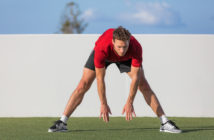Info Box
Manufacturer: Bulldog Gear
Price: €145
Level: Beginner
Time: 45 minutes
Using a plyometric (plyo) box to change up a workout program is really effective. Plyometrics are really useful to break through plateaus and keep the participant progressing. The only caution with plyometrics is that it is a high impact/ high weight-bearing group of exercises, therefore people with joint issues or overcoming injuries should avoid until strength and proprioception is regained.
These are our top plyometric exercises, even better as a finisher to your regular workout. For example, after doing a full body workout, performing box burpees until failure would be an excellent way to shock your body into adapting in different ways than it is used to.
If you aren’t already using them it’s definitely a great way to activate muscles you may not have even existed and keep your workouts exciting. Bare in mind most of these are capable of being done without a box, however the box adds an extra level of difficultly and progression which some people may not need straight away.
It’s also worth adding you don’t need to go out and buy a plyo box. Many of these exercises could be achieved at your local park, perhaps on a solid park bench or similar object.
 Before you continue, please remember that you need to warm up.
Before you continue, please remember that you need to warm up.
 If are are unsure about some of the terms used in this article, it’s worth having a quick read through our Glossary of Terms before you get started with your workout.
If are are unsure about some of the terms used in this article, it’s worth having a quick read through our Glossary of Terms before you get started with your workout.
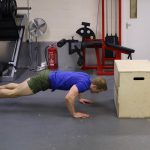
Pylo Burpees. Click for full exercise
x
01
Plyo Burpees
Burpees, probably the marmite of the bodyweight exercise world. This is a great fat burning exercise at the best of times; now try it with a box. Perform this variation by jumping onto the box at the end of the repetition. Also, to make it harder still at the press up part of the burpee perform the press up on the box.
Target: 5 burpee box jumps (beginner), 10 burpee box jumps (intermediate), 15 burpee box jumps (advanced)

Lateral Jumps. Click for full exercise
x
02
Lateral Jumps
By performing these up onto the box you recruit a larger number of muscle fibres, as you need to create a greater force to get up onto the box. Perform these up and on from one side and then down and off the other to making counting repetitions easier.
Target: 5 lateral jumps (beginner), 10 lateral jumps (intermediate), 15 lateral jumps (advanced)
Tip: The higher the box, the harder the jump.
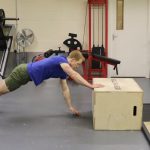
Walking Plank. Click for full exercise
x
03
Walking Plank
To make a plank even harder and challenge your core muscles to the max try the walking plank onto a box. With this you need to start in the plank position in front of the box and then, staying in the plank position, move one hand at a time onto the box and then back down. This will really challenge your core, targeting your obliques more due to the twisting motion that will occur. With this ensure the box isn’t too high so that getting back down isn’t impossible!
Target: 10 walking planks (beginner), 20 walking planks (intermediate), 25 walking planks (advanced)
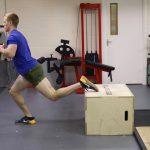
Split Squats. Click for full exercise.
x
04
Split Squats
Another highly cardio and legs based exercise sure to be a good leg day finisher. Perform this by moving your back leg onto the box as you do the ‘split’ part, lower until your back knee is just off the ground.
Target: 5 split squats per leg (beginner), 10 split squats per leg (intermediate), 15 split squats per leg (advanced)
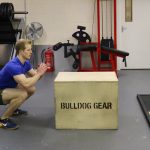
Double Legged Jump. Click for full exercise.
x
05
Double Legged Jump
A simple double-legged jump can be performed onto the box to increase the heart rate dramatically. This is excellent for working on jump height or some speed training – if working for speed ensure the box is secured.
Target: 10 jumps (beginner), 20 jumps (intermediate), 25 jumps (advanced)
Tip: Jump back down in to the squat position to make it tougher (to make it easier, simply step back off the box and start again)
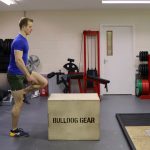
High Knee Pull. Click for full exercise
x
06
High Knee Pull
This is performed like an exaggerated high knee whilst stepping up onto the box. You step up with one leg and then raise the opposite knee up high, all in one fluid action, and step back down. Perform all of the repetitions on one leg and then the other. This is a great cardio quadriceps burner which will really work, speeding up the tempo is an easy way to increase the intensity.
Target: 5 high knees per leg (beginner), 10 high knees per leg (intermediate), 15 high knees per leg (advanced)
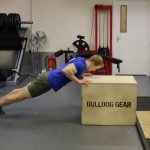
Incline Press Up. Click for full exercise
x
07
Incline Press Up
For the incline press up place your hands on the edge of the box and feet on the floor. This makes a press up slightly easier but also makes it easier to incorporate an explosive upward phase if you need something slightly harder.
Target: 10 press-ups (beginner), 15 press-ups (intermediate), 20 press-ups (advanced)
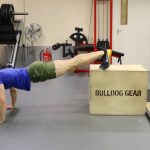
Decline Press Up. Click for full exercise
08
Decline Press Up
For the decline press up place your feet on the box, (higher than your heart). This is significantly harder than an incline or standard press up. It places more stress on the upper chest and onto the fronts of the shoulders, resulting in a slightly different workout from a normal press up. However, this is good if you’ve already mastered other press up variations and need a new challenge.
Target: 5 press-ups (beginner), 10 press-ups (intermediate), 15 press-ups (advanced)
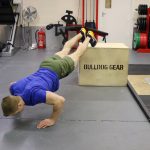
Decline Press Up Around The World. Click for full exercise
09
Decline Press Up Around The World
With decline press ups being quite a challenging exercise in itself, adding a moving element gives it an even more advanced spin. This requires the core to be engaged more whilst moving around the box and fatigues the chest, shoulders and arms quicker than a usual decline press up. This would be a great chest day finisher exercise.
Target: 4 press-ups around the box (beginner), 8 press-ups around the box (intermediate), 12 press-ups around the box (advanced)
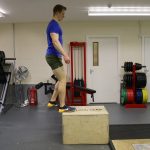
Reverse Lunges. Click for full exercise
x
10
Reverse Lunges
This requires quite a lot of balance, to be able to step backwards off the box on one foot. However, a great exercise to perform to strengthen the quadriceps and glutes in particular. This isn’t much different to a regular forward lunge, except from needing the extra balance and coordination to step backwards, therefore engaging more muscles and making the movement more difficult.
Target: 10 reverse lunges per leg (beginner), 15 reverse lunges per leg (intermediate), 20 reverse lunges per leg (advanced)
All of these exercises offer an alternative to finish your regular workout and really get the blood pumping. Or combine them together to create an independent workout to perform and reap the benefits of high intensity, big compound movements by smashing through plateaus.
 Before you finish, remember that you should spend time cooling down.
Before you finish, remember that you should spend time cooling down.
Post Views: 4,233
![]() Before you continue, please remember that you need to warm up.
Before you continue, please remember that you need to warm up.![]() If are are unsure about some of the terms used in this article, it’s worth having a quick read through our Glossary of Terms before you get started with your workout.
If are are unsure about some of the terms used in this article, it’s worth having a quick read through our Glossary of Terms before you get started with your workout.![]() Before you finish, remember that you should spend time cooling down.
Before you finish, remember that you should spend time cooling down.











